After having tested air quality monitors recently, we have been thinking more about indoor air quality, especially when using gas stoves, or during wildfire season. Here are our top picks for long lasting, ozone free, air purifiers to improve the quality of the air you and your family are breathing at home. Every purifier on this list is an ozone-free purifier, as certified by the International Association of Air Cleaner Manufacturers (IAACM).
There are plenty of excellent reasons to consider getting a home air purifier. There are multiple studies which suggest that an air filter can vastly improve your indoor air quality to reduce allergy symptoms and support improved respiratory and immune health overall, and HEPA filters are the gold standard. Heck, even NASA uses HEPA filters.
Why you need an at-home air filter
Indoor air pollution has a dramatic effect on health, with links to cardiovascular disease, cancer, and respiratory diseases, including acute respiratory infections and chronic obstructive pulmonary diseases. The World Health Organization (WHO) put out a report recently saying that a staggering 3.8 million premature deaths annually – including stroke, ischemic heart disease, chronic obstructive pulmonary disease (COPD) and lung cancer – are attributed to exposure to household air pollution.
See also: The best air quality monitors for home use
In addition to choosing household products like rugs, mattresses, and paint that don’t off-gas pollutants, use of air filters at home is a key strategy to improve indoor air quality. A quality air filter can also significantly reduce airborne allergens as well as pollutants.
In one study that took place over three to four seasons, researchers set up free-standing air filters and window air conditioners in the bedrooms of over a hundred kids with asthma and then monitored indoor air quality. They found that air filters reduced particulate matter levels by 50%. Similar results were seen in another study, where air filters reduced particulate matter by an average of 69-80%.
Air filters also filter out airborne infectious pathogens such as some viruses, bacteria, and fungi. Indeed, airborne droplets are responsible for diseases like tuberculosis, influenza, chickenpox, measles, and some types of herpes zoster.
Given the increase in globalization, as well as climate fires and other landscape fires in recent years, and the awful effects these have on indoor air quality, respiratory and cardiovascular health, it’s surprising that more public health officials haven’t emphasized the use of portable air cleaners.
How to choose the best air filter
For optimal air filtration, you’ll want to ensure four key things:
- Good air flow and ventilation in the room (and a suitably sized filter)
- An ability to filter out a range of particles, small to large, in different ways
- Easy maintenance and upkeep (and low-cost filter replacements)
- An ozone-free filter, as certified by the International Association of Air Cleaner Manufacturers (IAACM)
Let’s start with room size and certifications.
Certifications for air purifiers
As with any home appliance, we recommend you choose an air purifier that is Energy Star certified. You’ll be running your air purifier 24/7 (ideally), so a good energy efficiency rating offers a degree of assurance that the unit won’t bankrupt you or the environment. Energy Star models are around 40% more energy efficient than comparable models that don’t qualify for the star.

Ideally, you’ll also choose an air purifier with an AHAM Verifide seal and a CADR. This seal certifies that the model has been tested by the Association of Home Appliance Manufacturers and that you can trust the CADR or clean air delivery rate. The CADR is a measure of the volume of clean air an air purifier produces when it is operating at its top level. So, a CADR of 150 for tobacco smoke filters air in such a way as to be the equivalent of adding 150 cubic feet of clean air every minute.
As you’d expect, then, a higher CADR means greater efficiency and speed at filtering air. Be careful to check the CADR for different types of air pollutants, though. If your main concern is pollen, a model with a high CADR for formaldehyde doesn’t necessarily mean a high CADR for pollen, and vice versa. In general, a CADR of 240 or more is excellent, while a filter with a CADR below 60 isn’t going to be all that helpful.
Types of air purifiers
There are a few different options for at-home air filters, including whole-house filtration via your home heating system, air conditioning system, or ventilation, free-standing air filters (also known as portable air-cleaning [PAC] devices), or a combination of these.
Most PACs contain a fan that mechanically draws in airborne pollutants and then blows out cleaned air. These are usually a good choice for rooms where tobacco and/or wildfire smoke, pollen, dust mites, animal allergens, or exhaust particles are a problem. Some PACs are noisy, though, and they can also be energy-hungry.
A good quality air filter typically works in several ways, with a prefilter, a carbon filter, an antibacterial filter, and a HEPA filter. The latter is usually used in hospital and clinic settings as it uses mechanical filtration to remove airborne particulates. HEPA filters adhere to standards requiring a minimum 99.97% efficiency for removing particles measuring 0.3nm (1/83,000 of an inch) in diameter or larger.
As a general rule, stay away from ozone generators (ozone is bad for your lungs, so it makes no sense to filter air this way), and avoid ionizers and purely electrostatic precipitators as these can also produce ozone.
Basically, if you’re going to buy an air filter or air purifier, go for a HEPA system, whether it’s a freestanding unit or a filter that works with your existing HVAC. Ideally, any air filter or purifier will also have a prefilter and carbon filter to trap larger particles and any troublesome gases.
How much do HEPA filters cost to buy and maintain?
Mechanical (HEPA) filters typically need replacing every 6 months to a year to keep performing well. These can cost anywhere from around $80 to $200, depending on the make and model. An activated carbon filter needs to be replaced every 3 months as it gets saturated faster. These filters typically cost around $50. Replacing all of your filters on the recommended schedule helps the machine to perform at its best, which makes it far less likely to malfunction and require more serious maintenance or replacement.
Brands to consider for air purifiers
So, what about brands? Well, in a test of six commercially available brands, Hacker and Sparrow looked at three electrostatic precipitators and three HEPA filters. Of these, one offered no benefit at all, with this result also seen in another study. The unit in question was the heavily marketed Ionic Breeze Quadra – clearly an air filter to avoid. Of the six units tested, the HEPA filters worked best, while the electrostatic devices were less efficient.
The best performer of the six units tested was a stationary model designed for use at the headboard end of a bed to provide filtration to the “sleep breathing zone” (SBZ). This unit nearly completely removed all particles. The other two HEPA filters also performed well. Unfortunately, the authors did not provide the names of the models they used in this study, opting instead for a general comparison between HEPA and non-HEPA models.
Some of the most well-regarded brands for air purifiers include:
- Blueair
- IQAir
- Honeywell
Alen, Idyllis, and Kenmore also make decent models, but the three companies above consistently score well in independent testing.
And finally, if you’re not sure if you need an air purifier, consider investing in a home air quality monitor.
Below, we list our top-rated air filters – all of our selections are ozone free. You can read about our unique research process here.
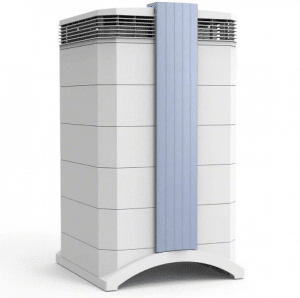
IQAir MultiGas GC Air Purifier
Highlights: One of the best air purifiers on the market, capable of assisting with VOCs, wood smoke, tobacco smoke, exhaust fumes, smog, and more.
- Ozone free
- Wheels make it easy to roll across a room
- Geared towards VOCs, smoke, and air pollutants
- Can filter indoor air pollution from gas stoves
- Big unit is difficult to move up and down stairs
- Component parts can become dislodged after moving which can make the unit noisy
- Expensive
If you’re mostly concerned about VOCs, wood smoke, tobacco smoke, exhaust fumes, or smog, the IQAir MultiGas GC is for you. This one contains a high-efficiency micro particle pre-filter with 32 sq. ft. of HEPA H11 Class material, providing particle removal down to 0.003 microns (95%). It also features a filter containing 12 lbs. of granular activated carbon and impregnated alumina. And, just to really seal the deal, the post-filtration sleeves contain 5.4 sq. ft. of electrostatically charged fibers to capture fine dust, making it a great option if you’re a woodworker.
This air filter is recommended for rooms of up to 285 sq. ft. for premium gas filtration or up to 1,125 sq. ft. for general-purpose gas filtration.
Our team lives in urban environments and mountain towns that are prone to smoke, which caused us to choose the IQ Air Multigas.
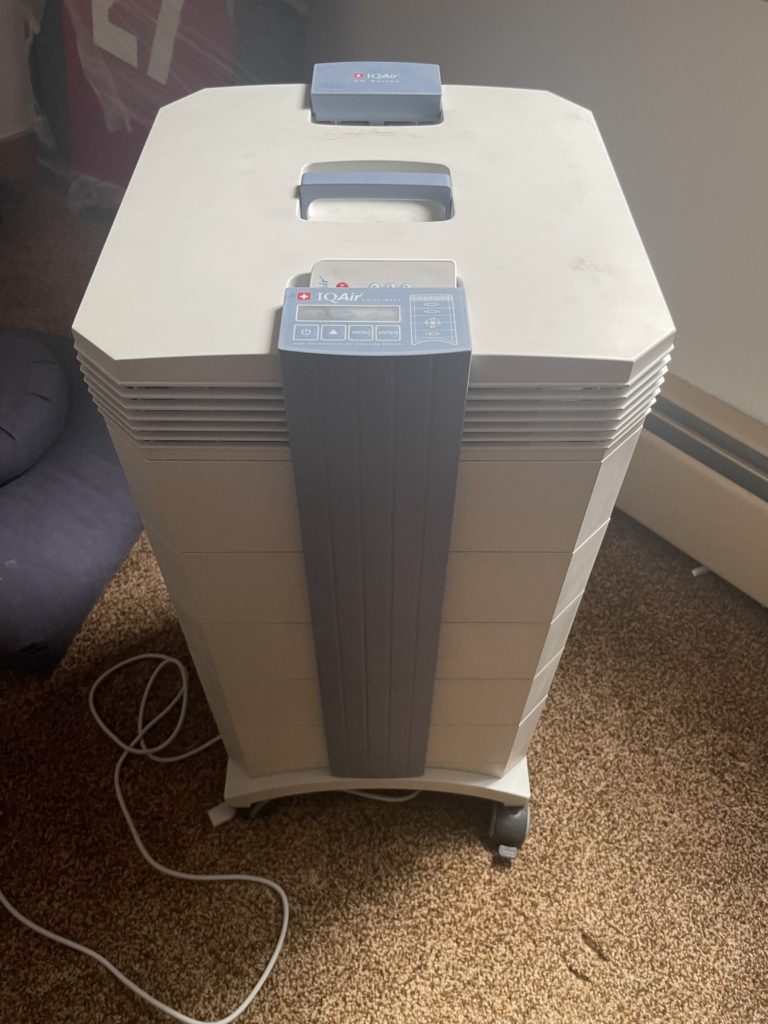
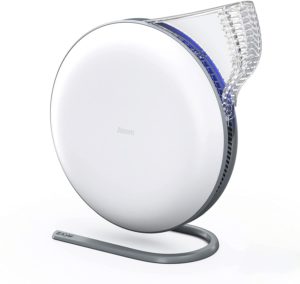
IQAir Atem Personal Air Purifier
Highlights: A great personal air purifier option that could fit on an office desk or beside table. It’s lightweight and portable in the best of ways, making it easier to bring it wherever you need.
- Ozone free
- Top of the line technology
- Portable
- Dual voltage – can be used internationally
- Only filters small 32 sq. feet
If you’re looking for a personal air purifier for use at your office desk or on your bedside table, the IQAir Atem is for you. This filter creates a clean air zone around you and is quiet, draft-free, and ozone-free. I also love that this air filter is lightweight (6 lbs!) and truly portable; you can quickly take it apart and pop it in your carry-on or suitcase (for when you get back to traveling!). And, handily, it’s dual voltage, so can be used anywhere in the world.
This air-filter contains 32 sq. ft. of HyperHEPA™ filtration media, providing particle removal down to 0.003 microns (99%). It also contains a PureJet diffuser that allows for optimal positioning whether you’re sitting, standing, or sleeping. So, set it up for your sit-stand desk and have wonderfully clean home office air.
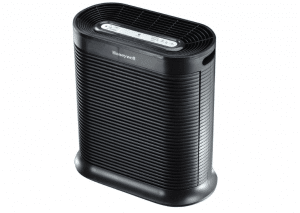
Honeywell HPA300 Air Purifier
Highlights: An affordable option that’s known for being remarkably quiet, effective, and great for larger rooms up to 465 square feet.
- Ozone free
- Affordable
- Lightweight
- Filters 465 sq. feet
- Could be more energy efficient
The Honeywell HPA300 is another good budget option for air purifiers. It’s pretty light (just 16.8 lbs) and has a carry handle, so is easy to move as needed and can be used on a table or the floor. This model is a true HEPA filter that is efficient at removing dust, smoke, and pollen even at its lowest speed. And it’s a touch quieter than the Blueair, making it a good option for in the bedroom at night or for a home office while you’re taking calls.
The Honeywell HPA300 really punches above its weight too. It’s great for large rooms up to 465 sq. ft. and captures up to 99.97% of airborne particles as small as 0.3 microns. It has a very impressive CADR of 300 for smoke, so is a really good choice for places at risk for climate fires as well as for anyone living with a smoker.
The controls on this model are easy to use and there’s a filter indicator to let you know when to change the mail filter. It also has a programmable timer!
As for the downsides, the Honeywell costs a little bit more to run than the Blueair Blue Pure but is Energy Star certified. Overall, this one is a good choice for a home office or bedroom. If your budget stretches to it, though, consider the IQAir Atem Personal Air Purifier for small spaces instead.
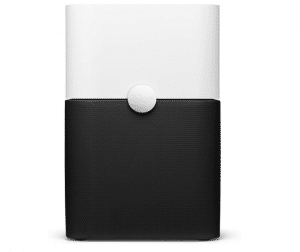
Blueair Blue Pure 211+ Air Purifier
Highlights: A budget option that’s quite a bit more attractive than some of its competitors at the cost of being a bit nosier with filters that can get pricy.
- Ozone free
- Attractive design
- Effective filtration
- Machine washable pre-filter
- High annual cost to run
If you’re looking for an attractive air filter and are on a budget, or if you’re just looking for an air purifier to tide you over while working from home, the Blueair Blue Pure 211+ is a great choice. This one can quickly and efficiently clear the air in a large room (up to 540 sq. ft.), removing dust, smoke, and pollen, as well as VOCs, odors, and other gases.
It’s an Energy Star model (30-61 Watts), has a machine-washable pre-filter and a filter indicator to let you know when the main filter needs changing, and costs under $300. The company also markets this one as having a Scandinavian aesthetic (it’s Swedish), and you can choose different filter colors and leave the filter housing cover off if you’d like a splash of color to your air purifier.
The downsides on this one include fairly high annual costs, with pricy filters. It’s also not that quiet, even at its lowest speed (31 dB), churning out 56 dB at its highest setting.